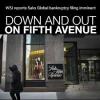
Breaking News
 If You Grew Up In The 1970s, You Probably Possess These Rare Traits
If You Grew Up In The 1970s, You Probably Possess These Rare Traits
 EVEN More SUPER SHADY Financial Dealings At TPUSA!
EVEN More SUPER SHADY Financial Dealings At TPUSA!
 British woman warns American about the Rise of Islam...
British woman warns American about the Rise of Islam...
 Saks Global prepares for bankruptcy after missing debt payment, WSJ reports
Saks Global prepares for bankruptcy after missing debt payment, WSJ reports
Top Tech News
 Laser weapons go mobile on US Army small vehicles
Laser weapons go mobile on US Army small vehicles
 EngineAI T800: Born to Disrupt! #EngineAI #robotics #newtechnology #newproduct
EngineAI T800: Born to Disrupt! #EngineAI #robotics #newtechnology #newproduct
 This Silicon Anode Breakthrough Could Mark A Turning Point For EV Batteries [Update]
This Silicon Anode Breakthrough Could Mark A Turning Point For EV Batteries [Update]
 Travel gadget promises to dry and iron your clothes – totally hands-free
Travel gadget promises to dry and iron your clothes – totally hands-free
 Perfect Aircrete, Kitchen Ingredients.
Perfect Aircrete, Kitchen Ingredients.
 Futuristic pixel-raising display lets you feel what's onscreen
Futuristic pixel-raising display lets you feel what's onscreen
 Cutting-Edge Facility Generates Pure Water and Hydrogen Fuel from Seawater for Mere Pennies
Cutting-Edge Facility Generates Pure Water and Hydrogen Fuel from Seawater for Mere Pennies
 This tiny dev board is packed with features for ambitious makers
This tiny dev board is packed with features for ambitious makers
 Scientists Discover Gel to Regrow Tooth Enamel
Scientists Discover Gel to Regrow Tooth Enamel
 Vitamin C and Dandelion Root Killing Cancer Cells -- as Former CDC Director Calls for COVID-19...
Vitamin C and Dandelion Root Killing Cancer Cells -- as Former CDC Director Calls for COVID-19...
Optical computing for deep learning with a programmable nanophotonic processor

Solja?i? says that many researchers over the years have made claims about optics-based computers, but that "people dramatically over-promised, and it backfired." While many proposed uses of such photonic computers turned out not to be practical, a light-based neural-network system developed by this team "may be applicable for deep-learning for some applications," he says.
Traditional computer architectures are not very efficient when it comes to the kinds of calculations needed for certain important neural-network tasks. Such tasks typically involve repeated multiplications of matrices, which can be very computationally intensive in conventional CPU or GPU chips.
After years of research, the MIT team has come up with a way of performing these operations optically instead. "This chip, once you tune it, can carry out matrix multiplication with, in principle, zero energy, almost instantly," Solja?i? says. "We've demonstrated the crucial building blocks but not yet the full system."
By way of analogy, Solja?i? points out that even an ordinary eyeglass lens carries out a complex calculation (the so-called Fourier transform) on the light waves that pass through it. The way light beams carry out computations in the new photonic chips is far more general but has a similar underlying principle. The new approach uses multiple light beams directed in such a way that their waves interact with each other, producing interference patterns that convey the result of the intended operation. The resulting device is something the researchers call a programmable nanophotonic processor.



